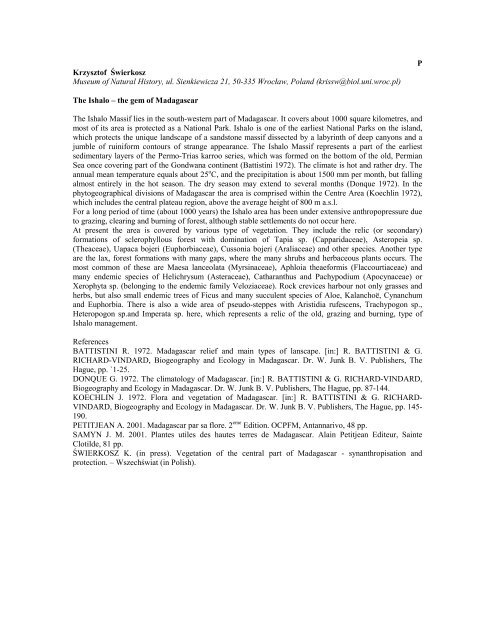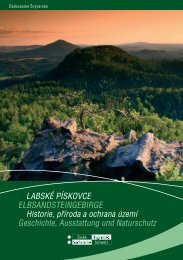Krzysztof ŚwierkoszMuseum of Natural History, ul. Sienkiewicza 21, 50-335 Wrocław, Poland (krissw@biol.uni.wroc.pl)PThe Ishalo – the gem of MadagascarThe Ishalo Massif lies in the south-western part of Madagascar. It covers about 1000 square kilometres, andmost of its area is protected as a National Park. Ishalo is one of the earliest National Parks on the island,which protects the unique landscape of a sandstone massif dissected by a labyrinth of deep canyons and ajumble of ruiniform contours of strange appearance. The Ishalo Massif represents a part of the earliestsedimentary layers of the Permo-Trias karroo series, which was formed on the bottom of the old, PermianSea once covering part of the Gondwana continent (Battistini 1972). The climate is hot and rather dry. Theannual mean temperature equals about 25 o C, and the precipitation is about 1500 mm per month, but fallingalmost entirely in the hot season. The dry season may extend to several months (Donque 1972). In thephytogeographical divisions of Madagascar the area is comprised within the Centre Area (Koechlin 1972),which includes the central plateau region, above the average height of 800 m a.s.l.For a long period of time (about 1000 years) the Ishalo area has been under extensive anthropopressure dueto grazing, clearing and burning of forest, although stable settlements do not occur here.At present the area is covered by various type of vegetation. They include the relic (or secondary)formations of sclerophyllous forest with domination of Tapia sp. (Capparidaceae), Asteropeia sp.(Theaceae), Uapaca bojeri (Euphorbiaceae), Cussonia bojeri (Araliaceae) and other species. Another typeare the lax, forest formations with many gaps, where the many shrubs and herbaceous plants occurs. Themost common of these are Maesa lanceolata (Myrsinaceae), Aphloia theaeformis (Flaccourtiaceae) andmany endemic species of Helichrysum (Asteraceae), Catharanthus and Pachypodium (Apocynaceae) orXerophyta sp. (belonging to the endemic family Veloziaceae). Rock crevices harbour not only grasses andherbs, but also small endemic trees of Ficus and many succulent species of Aloe, Kalanchoë, Cynanchumand Euphorbia. There is also a wide area of pseudo-steppes with Aristidia rufescens, Trachypogon sp.,Heteropogon sp.and Imperata sp. here, which represents a relic of the old, grazing and burning, type ofIshalo management.ReferencesBATTISTINI R. 1972. Madagascar relief and main types of lanscape. [in:] R. BATTISTINI & G.RICHARD-VINDARD, Biogeography and Ecology in Madagascar. Dr. W. Junk B. V. Publishers, TheHague, pp. `1-25.DONQUE G. 1972. The climatology of Madagascar. [in:] R. BATTISTINI & G. RICHARD-VINDARD,Biogeography and Ecology in Madagascar. Dr. W. Junk B. V. Publishers, The Hague, pp. 87-144.KOECHLIN J. 1972. Flora and vegetation of Madagascar. [in:] R. BATTISTINI & G. RICHARD-VINDARD, Biogeography and Ecology in Madagascar. Dr. W. Junk B. V. Publishers, The Hague, pp. 145-190.PETITJEAN A. 2001. Madagascar par sa flore. 2 eme Edition. OCPFM, Antannarivo, 48 pp.SAMYN J. M. 2001. Plantes utiles des hautes terres de Madagascar. Alain Petitjean Editeur, SainteClotilde, 81 pp.ŚWIERKOSZ K. (in press). Vegetation of the central part of Madagascar - synanthropisation andprotection. – Wszechświat (in Polish).
Krzysztof ŚwierkoszMuseum of Natural History, ul. Sienkiewicza 21, 50-335 Wrocław, Poland (krissw@biol.uni.wroc.pl)TGeobotanical analysis of the Stołowe Mts. (Poland, the Sudetes Mts.)The Stołowe Mts. is the largest Jurassic-cretaceous sandstone massif in Poland. It is a part of the MiddleSudetes, stretching in the western part of the Kłodzko Region, on the border of Poland and the CzechRepublic. The lowest section of the Stołowe Mts. is the valley of the Bystrzyca Dusznicka River (355 m),the highest peaks reaching 927 m a.s.l. (Mt. Szczeliniec) and 908 m a.s.l. (Mt. Skalniak). Those peaks aretypical table mounts, the only ones of this type in Poland. And thus the area is very important for Polishnature protection – the Stołowe Mts. National Park was established here in 1993, and it will certainly becomprised within the Natura 2000, a system of the European ecological network.The flora of the Stołowe Mts. contains about 1050 taxa. During my investigations (1992-1998) 885 taxawere discovered, rediscovered or confirmed; between them 12 species of plants listed in the Polish Red Listand 44 protected by law in Poland. Also, not fewer than 72 mountain taxa, 42 xerothermic plants and 53archeophyts occur here.There are 6 main phytogeographical divisions in the Stołowe Mts. The submontane level contains three ofthem. These are the Grodzic Massif (central part of the level), Obniżenie Kudowskie depression (westernpart) and the south-eastern piedmont division between Batorów and Polanica. The flora of the submontanelevel is of lowland character, and comprises many common lowland species such as Stellaria holostea,Carpinus betulus, Tilia cordata, Corydalis intermedia, Hedera helix, Hepatica nobilis, Lonicera xylosteum,Chamaecytisus supinus, Genista germanica, Orobanche elatior and others.The montane level comprises two divisions: Stoliwo (central part of the Stołowe Mts.) and the LewińskieHills. The first one is the best preserved area in the region and protects very interesting and rich flora, bothwithin limestone and sandstone habitats. Many rare and vulnerable species in Poland (e.g. Gentianellapraecox, Traunsteinera globosa, Dactylorhiza fuchsii, Orchis mascula, Arnica montana, Droserarotundifolia, Carex lasiocarpa, Ledum palustre) occur exclusively in this division. Saxifraga decipiens hasits sole locality in Poland in this level, close to the peak of Rogowa Kopa.The highest peaks of the Stołowe Mts. (from 850 to 927 m a.s.l.) have many both nature and landscapevalues, which makes them very different from the montane and submontane level. Some of highmountainouscommunities (Plagiothecio-Piceetum, community of alliance Rhododendro-Vaccinion) occurhere, and the relict populations of Pinus sylvestris, Pinus mugo (the second natural locality in the SudetesMts.) and Betula pubescens ssp. carpatica grow in this layer, too.ReferencesBORATYŃSKI A. 1978. Sosna błotna (Pinus uliginosa Neumann) w rezerwacie "Błędne Skały" w GórachStołowych. - Arboretum. Kórnickie 23: 261-267. (In Polish with an English summary).MIKYŠKA R. 1970. Poznamky k nekterym borum v Cechach a v Kladsku. - Preslia 42:130-135, Praha.PENDER K. 1996. Roślinność Gór Stołowych w aspekcie środowiskowych i antropogenicznychuwarunkowań. - Szczeliniec 0: 103-109. Park Narodowy Gór Stołowych, Kudowa Zdrój. (In Polish).PENDER K., MACICKA-PAWLIK T. 1996B. Saxifraga rosacea Moench na Rogowej Kopie w GórachStołowych. Charakterystyka naskalnych zbiorowisk z Saxifraga rosacea oraz otaczających je zbiorowiskleśnych. - Acta. Uniw. Wrat. 1886 Pr. Bot. 70: 5-20. (In Polish with English summary).POTOCKA J. 1999. Contemporary vegetation of the Great Bog of Batorów (Wielkie TorfowiskoBatorowskie. – Szczeliniec 3: 49-99. (In Polish with an English summary).SOLON J., ŚWIERKOSZ K. 1999. Flora PNGS [w:] M. Zgorzelski [red.] Góry Stołowe. WydawnictwoAkademickie “Dialog”. Warszawa. s. 122-127. (In Polish).SZEFER S., GOŁĄB Z. 2000. Traunsteinera globosa L. w Górach Stołowych. - Chrońmy Przyr. Ojcz. (InPolish).ŚWIERKOSZ K. 1996. Rare and protected vascular plants in the Stołowe Mts. National Park. [Rzadkie ichronione gatunki roślin naczyniowych w Parku Narodowym Gór Stołowych]. - Szczeliniec 0:117-123.Park Narodowy Gór Stołowych, Kudowa Zdrój. (In Polish with an English summary).ŚWIERKOSZ K. 1998. Charakterystyka geobotaniczna Gór Stołowych cz. I. Praca doktorska wykonana wMuzeum Przyrodniczym UWr. Mscr. (In Polish).




